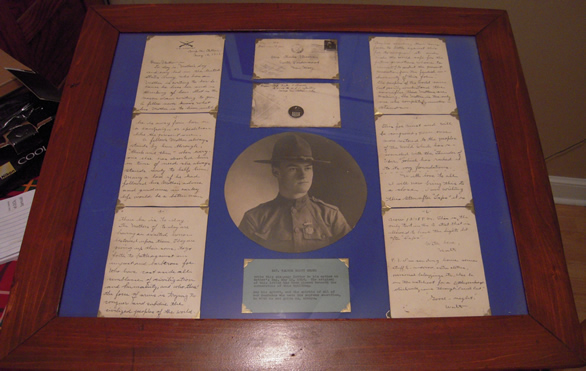Sgt. Walter Scott Brown
|
Below is a framed Portrait of Walter Scott Brown in the lower center.Above his portrait appears to be the original front and back of the envelope he sent home.On the back of the envelope has a three cent stamp of George Washington on it which has been cancelled. There is a circular postal stamp which, what I can read says–Anniston May 15, 12 p.m. 1918 McClellan Branch—the letter is addressed to “Mrs.Charles Brown North Hackensack New Jersey”. In the upper left where you would put your return address is written “May 15. 1918- Walt was 19 yrs.” Written up side downand underlined is a note which is written in script and says “Mother's Day Letter”. On the front of the envelope is a sticker where you seal an envelope at the end of the V, of the American emblem with the American Eagle on top of it. At the top of the front of the envelope is written “From Corp. Walter S. Brown Co. C 114th M.S.O. Infantry, Camp McClellan – Ala.” I do not know who wrote the notes on the envelope although we may conclude it was his mother because it was made out to her the note which says “Mother's Day letter” appears to be in different hand writing. The envelope with the cancelled stamp and the Postal stamp on it appears to be the actual envelope. Surrounding Walter Browns Portrait and the envelope is a hand written copy of the original letter he sent home for Mothers Day in May of 1918. I (Bob Meli) do not know as of February of 2010 who recopied the original letter, it could have been his mother or someone from the Post. Below Walter Brown's Portrait is a blue card which appears to have been written by someone from the Post, explaining the framed letter and where the original letter is and the blue card reads; |

|
Click on the image to go to Mother's Day Letter |
Sgt. Walter Scott Brown wrote this six-page letter to his mother on Mother's Day, May 12, 1918. The original of this letter has been placed beneath the cornerstone of this building. May his spirit, and the spirits of all of our comrades who made the supreme Walter Scott Brown was only 19 years old when he left with the Hackensack Company C which had been originally Company G. He was an aide to Captain Doremus and Captain Doremus made mention of Walter Brown in a letter home to his wife in October of 1918. In Walter Brown's Mother's obituary on November 3, 1960 it mentions that she was a member of the Harry Doremus. Written by: |